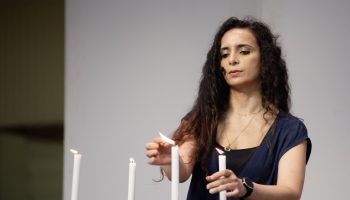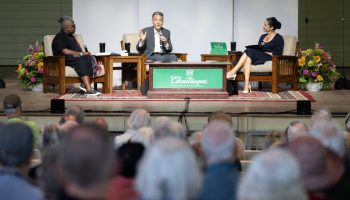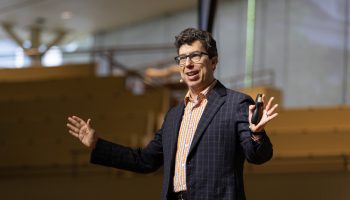
Homi Kharas, senior fellow at the Center for Sustainable Development, housed in the Global Economy and Development Program at Brookings Institution, speaks about the history and current state of the middle class during his Chautauqua Lecture Series presentation Tuesday in the Amphitheater.
Three years ago, Brookings Institution economist Homi Kharas was in the Amphitheater audience, attending a morning lecture. He was in the middle of working on the first draft of his latest book, The Rise of the Global Middle Class: How the Search for the Good Life Can Change the World, looking for inspiration on how to describe “how the middle class contributes to and benefits from a more civil society, and honestly what better place to do that than here at Chautauqua?”
At 10:45 a.m. Tuesday morning, Kharas himself took the Amp stage to give a lecture, part of the Week Four theme of “Eight Billion and Counting: The Future of Humankind in a Crowded World.” He used the book he was working on at Chautauqua, now published and out in the world, to frame his talk.
Some focus on governmental policies and regulations, international treaties, or cutting-edge technologies to solve the world’s ills. But “the most powerful lever for change,” Kharas argued, “lies in the wallets and votes of the middle class” — 4 billion people, responsible for spending $60 trillion every year in a global economy of $100 trillion. This population, is “realizing that the current economic model is not delivering, and they’re pushing for something new,” Kharas said.
The “basic equation” for happiness, going back to the Greeks, is that happiness, or the pursuit of a good life, is living well and doing well. There’s a lot of focus on the “living well” part of the equation — everyone, after all, wants more economic prosperity. It’s in the “doing well” part of the equation that the world economy does poorly, and where the middle class, he said, is demanding change.
When the middle class “struggles for something, so far, it’s won,” Kharas said, pointing to women’s suffrage and child labor laws, state pensions and Social Security. With Gen Z becoming the first generation with what Kharas would call a “true middle-class outlook” that wants both the “living well” and “doing well” part of the equation, he’s optimistic.
With that, Kharas dove in, first with the formal definition of the term “middle class.” The Oxford English Dictionary is amusingly simplistic: “It says the middle class is the class of people between the upper class and the lower class,” he said, to laughter in the Amp, “Or, alternatively, it’s the class whose members are neither very rich nor very poor.”
Since the middle class is defined by what it is not, Kharas said in order to understand it, one must first define the upper class and the lower class.
“I think of the upper class as a group that doesn’t have to make economic choices. If a rich person wants something, they just buy it — they don’t have to give up on something else,” Kharas said. “Poor people don’t have that much economic choice. They struggle to pay for the basic necessities of food and rent and clothing.”
Thus, since they have discretionary income — however finite — the middle class is the only group that actually makes economic decisions.
Kharas looked at what it would cost people — in different eras, in different parts of the world, with different family sizes, and accounting for inflation — to have a standard of living that “goes beyond the basics.” His starting point was a junior bank clerk in Victorian England, the first recognizable middle-class group in history.
During the Industrial Revolution, factory owners needed loans for machinery; the loans had to be drawn up by people who could read and write. There weren’t many educated people at the time, Kharas said, but tens of thousands of clerks were hired between 1850 and 1870 in London.
From historical records, it’s known that entry-level clerks were paid 100 pounds a year. That’s about $22,700 in modern U.S. currency. Kharas looked at contemporary examples, as well.
He pointed to recent work from a team of Mexican economists, who studied the impact of unemployment, sickness or disability on standards of living. Some coped well; those were families with income from two or more people, with savings and access to credit.
“Others were not so fortunate and fell into extreme poverty,” Kharas said. “By comparing how many people were in each of these groups, the experts were able to define the middle class as those with incomes that were high enough so that a family would have less than a 1 in 10 chance of falling into extreme poverty at any point in time over a three-year period. In other words, the Mexican analysts defined the middle class as those resilient enough to withstand a major economic shock.”
The middle-class threshold, despite coming from a different type of calculation, was very similar to that determined by the Victorian bank clerk standard. Remarkably, the threshold for entry into the middle class is “exactly the same” in contemporary India. Kharas found the same in Portugal and Italy, as well.
There are other definitions, however, of the middle class that give different results — notably, the most common one used in the United States, where the Pew Research Center defines middle class as “the group with income levels between two-thirds to twice the median national incomes.” The problem with that definition, Kharas said is that it ties the size of the middle class to a country’s average income.
“It can produce slightly odd results” in country-by-country comparisons.
If an economic middle class is one that isn’t rich or poor, can withstand economic shocks, and is able to maintain a certain lifestyle, Kharas estimates there are 4 billion people in the global middle class. How did this group get so big?
Before the Industrial Revolution, there was “almost no middle class, anywhere.” In addition to the Industrial Revolution, he said, European colonial expansion gave the middle class a hand, as well — turns out “educated armies performed far better in combat than uneducated armies.”
Hence the push for universal basic education in the second half of the 19th century, boosting middle class numbers.
By the mid-1970s, the global middle class reached 1 billion, albeit concentrated in North America, Europe and Japan. Globalization drove the next big increase, and another 1 billion joined the middle class by 2006 — just 31 years. By that time, China had gained admittance to the World Trade Organization, and despite low wages, the rise of two-income families and government-issued homes in China saw a ballooning middle class. By 2014, yet another billion were among the global middle class.
As the global economy became more digitized, the work of Indian software engineers was more and more in demand; money “flooded into India,” and its economy grew faster than any other major player in the world. After 2014, “Indians started to enter the global middle class in a big way,” Kharas said. Now, half of the world’s population is considered middle class, and Kharas predicted another 1 billion people would enter the middle class every eight years, primarily in Asia.
Such expansion, however, does have its drawbacks; chief among them is that, in trying to satisfy the appetite for goods and services in the cheapest way possible, “we’ve developed an economic system that’s causing huge damage,” Kharas said, from climate change to pollution to mass extinction events.
Society has the technical means to preserve a livable planet, and it doesn’t mean lowering the standard of living or stopping economic growth. The strategy for decarbonization is actually pretty clear, Kharas said: “Use electricity generated through renewables for all our energy needs and change land use to absorb more carbon from the air. The technologies already exist in most areas.”
Upfront costs associated with such a massive energy transition are a challenge — for both companies and for consumers. But remember, Kharas said, “it’s the middle class that has enough financial power to make the necessary investments and to spur companies to keep innovating to bring costs down.”
Agricultural land use is another challenge — but most of the crops grown by humans aren’t used to feed humans. Ninety percent of American cropland goes into animal feed, he said.
“If the global middle class would give up eating just beef and lamb, we could cut global cropland by half and give back to nature an area the size of North America,” Kharas said. Easier said than done, but it does point to the impact a middle-class diet shift could have.
Middle-class consumption is also driving the destruction of nature just through the sheer amount of stuff the average person uses — and disposes of — every day. On average, he said, each person in the global middle class uses their body weight in material each day; at least one-third of that is not managed sustainably, and in developing countries where the middle class is growing the fastest, half of all waste is dumped into the ocean.
“When the middle class was small and just concentrated in advanced countries, waste was just exported to developing countries and dumped there,” Kharas said. “Now there’s more waste and no place to put it.”
The old (read: current) system, Kharas said, is basically take, make, dispose. That system has reached its limits, but it’s being replaced by something called sustainable consumption and production — a new system that uses material over and over again.
Recycling is not a new practice, he said, but even with 50 years’ experience recycling plastic, only 10% is actually recycled. Add to that single-use plastics, and the fact that “you’ve got a bunch of humans who don’t bother to recycle,” he said, “it’s not working terribly well.”
Government regulations on plastic use can be heavy-handed, and while renewable energy, conservation, preservation, recycling and the like have all been championed for quite some time, “they’ve never been able to really mobilize a mass movement on a global scale.”
That’s what is different now, Kharas said.
“Will the middle-class, pursuing its own self-interest — not try to save the planet but pursuing its own self-interest and values — provide the incentives to steer the global economy in a new direction?” he asked.
There is enough evidence to indicate the middle class is taking this seriously. For example, more than two-thirds of the largest consumer-facing businesses in the world have made net-zero pledges. It might be to build brand loyalty and maximize profits, Kharas said, but “in doing so, they are changing the face of climate economics.”
“You might just say that’s just corporations trying to be good global citizens and business leaders, realizing they have a duty to change, but it isn’t,” he said. “The only good corporate citizens are those who have to explain themselves to consumers.”
Those are the companies “desperate to attract” Gen Z — the young adults on track to become the largest, wealthiest generation ever, he said. More than half of Gen Z are positively inclined to buy things from a brand that’s dedicated to social impact, gives proceeds to charity, is environmentally conscious and has strong values.
“That’s the new power of the middle class,” Kharas said. “By integrating their values into their choices, they are moving markets. … Issues that, for years, have been unable to advance beyond a narrow circle of advocates are now gaining traction because they have these billions of middle-class consumers behind them.”
Companies still game the system, Kharas said, and greenwashing remains a troubling trend; but in many developed countries, mandatory comprehensive standards for reporting carbon emissions are becoming more common. More importantly, those standards are “interoperable, so that companies doing business in multiple jurisdictions won’t have to file multiple reports,” with a basic structure developed by the International Sustainable Standards Board.
“It’s a profound change in the marketplace that could have dramatic consequences for sustainability,” Kharas said.
The global marketplace is one thing; a global treaty is another.
“We tried that with the Kyoto Protocol,” Kharas said. “… It never came to anything.”
The idea of a treaty seems even more far-fetched in 2024, but at the same time, “every country wants to be a player in the global marketplace.”
“No country on its own will be able to develop a sustainable consumption or production system … but when companies in all countries are competing for the large prizes that are offered by the global marketplace, I think we can get really rapid progress,” Kharas said.
There’s reason to be optimistic, he reiterated, but only if the middle class maintains the momentum.
“The middle class across the world is feeling exhausted,” he said. He cited the opioid crisis, the idea in the United States of “quiet quitting.” This burnout, this opting-out, matters.
“If the middle-class isn’t happy and if it drops out of the game, they will lose their political power and their ability to influence government policies and regulations that will ultimately steer the global marketplace — all those things like energy standards or mandatory sustainability reporting,” Kharas said.
This is why practices adopted during the pandemic — remote work, hybrid work, flextime — are important. It comes back to the idea of living well and doing well. The Harvard Study of Adult Development, conducted since 1938, unequivocally shows that the strength of people’s social relationships are a better predictor of contentment than money, fame, social class, IQ or genes. More available time by virtue of remote or flexible work means more time for investing and building relationships. All of the evidence, Kharas said, “suggests that it’s perfectly possible to have middle-class levels of prosperity, and have businesses that innovate more to support a healthy planet — and give people more time to strengthen the nonmaterial part of their lives.”
As Kharas wrapped up his lecture, he said he wished he could end on an optimistic note: “The market driven by the middle class is going to solve all our problems.”
But there are two real risks he wanted to convey; the first was artificial intelligence, and it’s threat to middle-class jobs, and the second was politics.
“The reason why the middle class has grown so rapidly is that it’s historically proven to be so adept at building political alliances to get the kinds of things that it wants,” Kharas said, referring back to the pushes for women’s rights, child labor laws, and more. “… It’s now fighting to promote sustainability, but against some really powerful vested interests.”
Despite those risks, Kharas said he is still convinced that the middle class is the “best hope for solving the big problems,” by connecting issues like climate change “as closely as possible with people’s lives, their livelihoods and their pursuit of happiness.” The future depends on how and where the middle class uses their wallets and their votes.
“I daresay that most people who come to Chautauqua are middle class,” he said. “So it’s your choices that will make a difference. Please choose well.”




